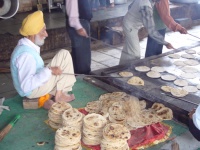Template:AOW82
Langar in Delhi
Free-for-all is a term generally used to describe chaos. And chaos is a word one could use to describe much of Delhi. But at the Gurdwara Bangla Sahib kitchen, a Sikh temple which serves meals to around 10,000 people every single day, there's not a trace of chaos. And the food is free. For all.
This week, Alex and I are at the Doors of Perception conference in India, where the theme is "Food and Juice." It's an exploration of food systems worldwide, and the energy required to make them go. On the first full day of the conference, the fifty-odd attendees split into small groups to go exploring the city of Delhi through its food culture. A number of groups focused on the prolific street vendor network, several looked at Delhi's water, and my group of nine went to Gurdwara Bangla Sahib to see how they achieve the daunting task of feeding thousands of people in single a day.
As Debra Solomon told us when introducing the excursion the previous evening: "They do the most exquisite dishwashing ritual you'll ever see." But actually, the Sikh guide who escorted us through the temple grounds told us in no uncertain terms that the kitchen activities are absolutely without ritual. "Cooking food is cooking food," he said, "No ritual. Just cooking." But if it can't be called a ritual, it can surely be called a dance -- a rhythmic, continuous choreography with mounds of dough, cauldrons of lentils, dozens of hands, and an endless stream of hungry visitors. ...Continued.

